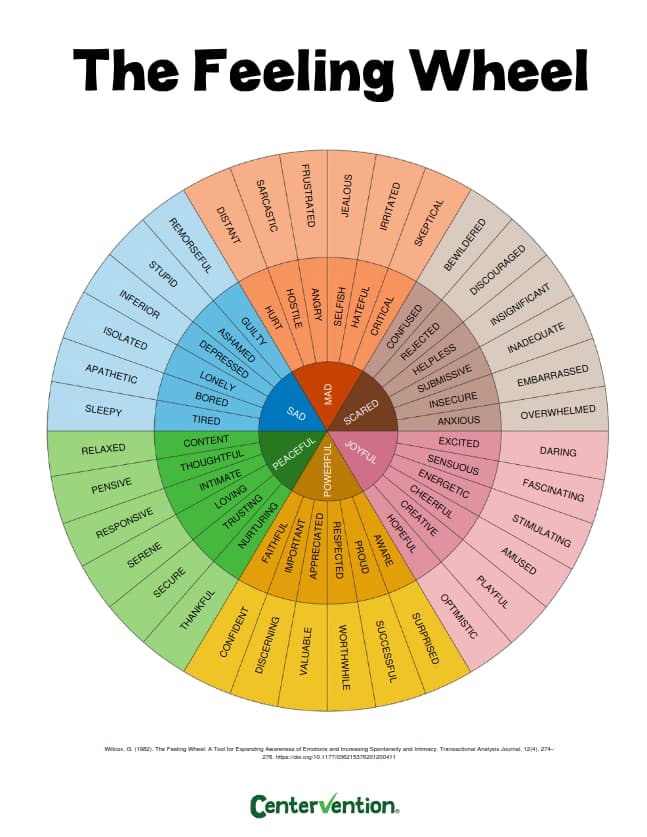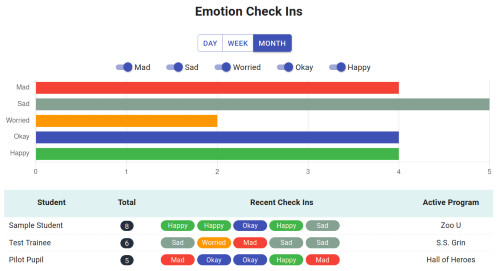The Feelings Wheel is a tool created by Gloria Wilcox in 1982 for teens and adults seeking to better understand and explain their emotions. This unique circular design allows users to navigate and explore their feelings, moving from broader categories to more specific emotions, thereby fostering emotional intelligence, self-awareness, and effective communication.
However, for younger kids, the complete feelings wheel is a bit too complicated.
So, to help, we’ve created a PDF with three different feelings wheels:
- The original feelings wheel created by Gloria Wilcox
- A feelings wheel with 5 choices and corresponding emojis
- An extension of option 2 that adds 3 additional choices for each of the 5 primary feelings
And we outlined a few ways that you can use the Feelings Wheel with your students in the lesson below.
Note: It may be helpful to have this list of emotions as a resource to reference for improving emotional literacy.
Recommended Grade Level: Elementary and Middle
SEL Skill(s): Communication, Emotion Regulation
Duration: 30 minutes
Materials: Feelings wheel worksheets (available when logged in to your free Centervention Educator account)
Suggestions For Using The Feelings Wheel
Using a feelings wheel is a great way to promote emotional intelligence and self-awareness and here are seven ways to incorporate it into the classroom:
- Emotional Check-In: Begin each day with a quick feelings check-in. A great way to do this is by using our free, online SEL check in or using a print out of the feelings wheel.
- Emotional Journal: Provide students with individual feelings wheels and journals. Encourage them to write about their emotions regularly, using the wheel to identify and explore how they feel and why. This practice can help students process their feelings and build self-expression skills.
- Feeling Charades: Play a game of charades using the feelings wheel. Each student takes turns acting out an emotion without speaking, and their classmates try to guess which emotion they are portraying.
- Art Projects: Assign emotions to small groups of students, and have each group create a drawing that represents the assigned emotion. This activity encourages creativity and empathy as students try to understand and depict different feelings.
- Emotional Storytelling: Divide the class into pairs or small groups and give each group an emotion from the wheel. Have them create and share short stories or skits that revolve around that specific emotion. This activity promotes empathy and understanding of different emotional experiences.
- Emotional Vocabulary: Pick an emotion from the feelings wheel each week and focus on expanding the students’ emotional vocabulary. Discuss synonyms for the chosen emotion and explore scenarios where they might feel that way.
- Feelings Collage: Using magazines, newspapers, and other art materials, ask students to create collages representing different emotions using images and words they find. This activity allows them to express their feelings and understand a range of emotions.
- Emotion in Books: Read age-appropriate books or short stories that explore a range of emotions. After reading, discuss the emotions the characters experienced and relate them to the feelings wheel.
Encourage open communication and emphasize that all emotions are valid and part of being human.
Free Online Feelings Check In
Each day, when a student log in to their online Centervention account, they will be asked how they are feeling. They can select one of the following five options: Mad, Sad, Worried, Okay, Happy.
All of these student emotion check ins are recorded and displayed in your educator dashboard where you can determine, at a glance, which students may need additional support. Educators can create a free account here.
Additional Resources
Books
- The Lonely Little Emoji by Harry Harmon
- H is for Happy by Evan Nimke (for younger students)
- The Way I Feel by Janan Cain


